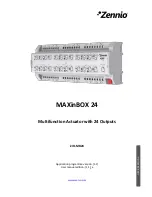
2 POWER SUPPLY, RESET, AND CLOCKS
2-12
Seiko Epson Corporation
S1C17M20/M21/M22/M23/M24/M25
TECHNICAL MANUAL (Rev. 1.0)
OSC1 oscillation stop detection function
The oscillation stop detection function restarts the OSC1 oscillator circuit when it detects oscillation stop under
adverse environments that may stop the oscillation. Follow the procedure shown below to enable the oscillation
stop detection function.
1. After enabling the OSC1 oscillation, check if the stabilized clock is supplied (CLGINTF.OSC1STAIF bit = 1).
2. Write 1 to the CLGINTF.OSC1STPIF bit.
(Clear interrupt flag)
3. Write 1 to the CLGINTE.OSC1STPIE bit.
(Enable interrupt)
4. Write 0x0096 to the MSCPROT.PROT[15:0] bits. (Remove system protection)
5. Set the following CLGOSC1 register bits:
- Set the CLGOSC1.OSDRB bit to 1.
(Enable OSC1 restart function)
- Set the CLGOSC1.OSDEN bit to 1.
(Enable oscillation stop detection function)
6. Write a value other than 0x0096 to the MSCPROT.PROT[15:0] bits. (Set system protection)
7. The OSC1 oscillation stops if the CLGINTF.OSC1STPIF bit = 1 after an interrupt occurs.
If the CLGOSC1.OSDRB bit = 1, the hardware restarts the OSC1 oscillator circuit.
Note: Enabling the oscillation stop detection function increase the oscillation stop detector current
(I
OSD1
).
2.4 Operating Mode
2.4.1 Initial Boot Sequence
Figure 2.4.1.1 shows the initial boot sequence after power is turned on.
V
DD
Reset request from POR
IOSCCLK
(Initial SYSCLK)
Internal reset signal
SYSRST, H0, H1
S1C17 core
program counter (PC)
Cancel reset request
Undefined
Undefined
∗
1
∗
1: Reset vector (reset handler start address)
∗
2: Address (reset 2)
∗
2
Cancel reset request
Reset hold time t
RSTR
Figure 2.4.1.1 Initial Boot Sequence
Note: The reset cancelation time at power-on varies according to the power rise time and reset request
cancelation time.
For the reset hold time t
RSTR
, refer to “Reset hold circuit characteristics” in the “Electrical Characteristics” chapter.
2.4.2 Transition between Operating Modes
State transitions between operating modes shown in Figure 2.4.2.1 take place in this IC.
RUN mode
RUN mode refers to the state in which the CPU is executing the program. A transition to this mode takes place
when the system reset request from the system reset controller is canceled. RUN mode is classified into “IOSC
RUN,” “OSC1 RUN,” “OSC3 RUN,” and “EXOSC RUN” by the SYSCLK clock source.
HALT mode
When the CPU executes the halt instruction, it suspends program execution and stops operating. This state is
HALT mode. In this mode, the clock sources and peripheral circuits keep operating. This mode can be set while
no software processing is required and it reduces power consumption as compared with RUN mode. HALT
mode is classified into “IOSC HALT,” “OSC1 HALT,” “OSC3 HALT,” and “EXOSC HALT” by the SYSCLK
clock source.















































